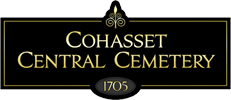Cars and Carriages
Gilbert Tower
Reproduced, with permission, from Treasury of Cohasset History, ed. J. M. Dormitzer (Town of Cohasset, Mass., 2005), pp. 160-163.
No young person living in Cohasset today can imagine what the conditions of life were years ago before automobiles changed everything. My first recollections about automobiles began about 1905 . . . My first ride in an auto was with our family friend Mr. Sturdy . . . He had a Stanley Steamer, which was expected to become very commonly owned . . . In front it carried a small water tube boiler, about the size of a washtub. It had to be filled from a convenient brook. There was a kerosene burner that had to be pumped up to build the steam pressure to 100 pounds. Then it would go like a streak, although the road was not too good. It had a throttle that admitted steam to the two-cylinder engine, which sounded “chou … chou.” The Stanley Steamer was fun to drive, but gasoline motors replaced it.
My father, Daniel N. Tower, decided that he must have an automobile. He claimed to have had one of the first high-wheel cycles as a boy and he wanted to be about the first one in town to have an automobile. We went to Boston and shopped around. The first automobile manufacturers had small agencies. The Pierce Arrow Company had put out its first model, which was called a Motorette. It was a one-seated, two-passenger car that was steered by a horizontal bar . . . It had a small two-and-a-half power Dedion Bouton motor made in France. To start it, the motor had to be cranked by hand. My father was very proud of it and remarked that it was so well built ''it ought to last a good many years." He did not figure on obsolescence. As a matter of fact it was driven around Cohasset many years, and its ".put ... put" gave it the name of "coffee grinder.'' No license was required to drive it and no registration was necessary for it . . .
In his work as superintendent of the Cohasset Water Company, my father needed to do a good deal of driving around town, but he had been accustomed to a horse and wagon. So his mind had inclined toward a high-wheeled vehicle, and for that work he had a vehicle that was driven by a belt. It was a mistake, as it would not go up hills, so it had to be sold . . . Eventually we had a Winton with two opposed cylinders that went "chug ... chug." Numerous companies undertook to sell automobiles that they had put together by assembling motors and parts made in other plants.
Before automobiles transportation was furnished by horses and carriages. There was considerable local business to build upholstered carriages, gravel carts, and ''barges,'' all to be horse drawn. A variety of businesses in town served the needs of horses and carriages. There were numerous blacksmith shops where horses were fitted with iron shoes. Open fields provided grass for grazing and drying to make hay for feed and "bedding." A harness maker used leather for harnesses, saddles, bridles, and reins. Now all that is gone. Instead we have filling stations, body shops, sales and service shops. Nobody thinks of walking anywhere, even to go to church.
Formerly horses littered the streets with manure. The manure bred flies. Few can fully remember what pests flies and also mosquitoes were (before spraying for mosquito control). There were numerous milk farms in Cohasset. The cows being driven to and from pasture spread offensive manure. Now the town is clean to live in, and young people should be grateful for the changed conditions, but they should not throw beer cans and bottles around.
One day Father and I were headed for Boston, and I was driving. At the "S" curve where Main Street crosses Weir River, the Hingham chief of police ''Wash'' (Washington) James and a helper had established a speed trap. They stopped us and claimed we were speeding at 12 miles per hour. It was a hold-up to raise money, and my father had to pay a $10 fine to the Hingham court.
Gasoline consumption was small. I used to take a pail to St. John's store at the foot of the Common, opposite the end of Depot Court, where he dispensed gasoline from a steel barrel. That area, which is now a memorial park, was then a confusion of stable, wagons, and miscellaneous buildings including a post office. The stable burned and the ruins had to be cleared away. Joseph St. John could not do it, so a number of public-spirited residents formed the Cohasset Improvement Society.
There were then three unsightly places to be cleared away. One was the Tilden Livery stable, opposite the railroad station. It was a big wooden structure and a fire hazard. Now there is a park where it stood. Another eyesore besides that mentioned at the foot of the Common was the vacant Hanlon Studio, where stage scenery and costumes were made. There were five Hanlon brothers from England who started as gymnasts but who developed a slapstick stage show called Hanlon's Superba. Every spring a group of dancers would arrive from New York and rehearse for Superba before it went on the road. It was comedy entertainment to children. The buildings were between Ripley Road and the railroad, opposite the present post office. The present South Shore Art Center [Adrian Morris Salon] now occupies one small building of the Hanlon Company . . .
One could go on forever reciting the changes that have occurred and been forgotten. Railroads covered the country. Now they have been superseded by air routes. Where will it end?
From Gilbert Tower, “The Car after the Horse,” Cohasset Mariner, March 12, 1981. Reprinted by permission of the author’s daughter, Frances Tower Maroni.

